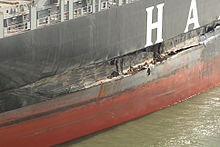Cosco Busan oil spill
| Cosco Busan oil spill | |
|---|---|

The damaged MV Cosco Busan after striking the bridge tower fender
|
|
| Location | San Francisco Bay |
| Coordinates | 37°48′03″N 122°22′29″W / 37.80073°N 122.37486°WCoordinates: 37°48′03″N 122°22′29″W / 37.80073°N 122.37486°W |
| Date | 7 November 2007 |
| Cause | Cosco Busan collision with the San Francisco–Oakland Bay Bridge in thick fog. |
| Operator | Fleet Management Ltd. |
| Volume | 53,569 US gal (202,780 l; 44,606 imp gal) |
| Area | 150 sq mi (390 km2) |
| Shoreline impacted | 26 mi (42 km) |
The Cosco Busan oil spill occurred at 08:30 UTC-8 on 7 November 2007 between San Francisco and Oakland, California, in which 53,569 US gal (202,780 L) of IFO-380 heavy fuel oil, sometimes referred to as "bunker fuel", spilled into San Francisco Bay after the container ship Cosco Busan, operated by Fleet Management Ltd., struck Delta Tower of the San Francisco–Oakland Bay Bridge in thick fog.
Investigators found that maritime pilot John Cota was impaired because of his use of prescription pharmaceuticals while piloting the container vessel, which rendered him unable to use the onboard radar and electronic navigation charts correctly. This occurred despite the fact that the Vessel Traffic Service of the United States Coast Guard warned Cota that the vessel was headed for the bridge. Cota was sentenced to 10 months in federal prison for his role in the incident.
Then California Governor Arnold Schwarzenegger declared a state of emergency after meeting federal, state and local officials overseeing the cleanup. The proclamation made additional state personnel, funding and equipment available to assess and clean up the environmental damage.
The National Transportation Safety Board determined the following probable causes of the accident:
Other contributing factors included:
In addition, investigations conducted by independent experts from the international maritime community also highlighted the potential effects of insufficient Human-machine interface design, contributing to such accidents even though "human error" is often directly used as the main cause without further investigating shortcomings in the HMI. This is, even though HMI has been accepted as a significant factor in aviation accidents for many decades:
...
Wikipedia
